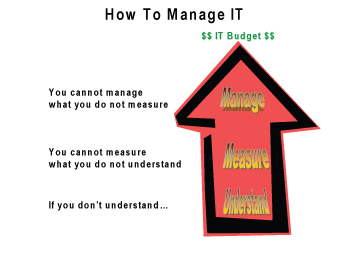Managing Meta Data for the Business: IT Portfolio Management – Part 3
By David Marco
Corporate Challenges
· Reduce IT redundancy
· Provide IT portfolio management
· Prevent IT applications failure
· Reduce IT expenditures
· Enable knowledge management
· Adhere to regulatory requirements
· Enable enterprise applications
IT Portfolio Management
Over the years, we have performed dozens of datawarehousing assessments. During these assessments, clients are routinely asked how much they spend annually on data warehousing. Most cannot accurately estimate what they actually spend. In order to manage these and any other costly IT initiatives, it is critical to measure each one, but it is impossible to measure them when most companies do not understand them. This is where IT portfolio management enters the picture. (see Figure 1)
This is where IT portfolio management enters the picture.

Figure 1: How to manage IT
IT portfolio management is the formal process for managing IT assets. An IT asset may be software, hardware, middleware, an IT project, internal staff, an application, or external consulting. As with other new disciplines, many companies are not setting up IT portfolio management efforts correctly. Following are some of the keys to building successful IT portfolio management applications.
The information that portfolio management targets is meta data (both business and technical), and, as such, needs to be stored in the MME. The MME will allow the corporation to aggregate the portfolio-related meta data into an executive view so that it is clear which projects are proceeding well and which are lagging behind. It can also publish information to a Web site so that front-line IT staff can see the status of other projects. This will greatly aid their project timelines and planning.
It should be directly linked to the more granular business and technical meta data to allow developers to understand what IT projects are underway, what technologies are these projects implementing, and what data sources they are accessing. Most large companies have a great deal of duplicate IT efforts (see the next section for more on this topic). This happens because the meta data is not accessible. At my company, we have a couple of large clients whose only goal is to remove these tremendous redundancies, which translate into tremendous initial and ongoing IT costs.
Finally, the MME should contain both a business and a technical component. In most cases, the business component is more complicated than the technical. For example, a project manager communicates a project’s funding, status, and technology to the group responsible for the portfolio management application. The meta data in the portfolio application is only as good as the information that these managers provide, so it is vital to integrate the IT portfolio application into the company’s IT production turnover procedures. This ensures that the portfolio application stays current[1].
Prevent IT Applications Failure
When a corporation looks to undertake a major IT initiative such as a CRM, ERP, a data warehouse, or an e-commerce solution, the likelihood of project failure is between 65 percent and 80 percent, depending on the study referenced. This is especially alarming considering that these same initiatives traditionally have executive management support and cost many millions of dollars. For example, one large client was looking to roll out a CRM system (for example, Siebel, Oracle) and an ERP system (for example, SAP, PeopleSoft) globally within 4 years, with an initial project budget of over $125 million. In my opinion, they have a 0 percent probability of delivering all of these systems on time and on budget. When was that last time you saw an ERP or CRM initiative delivered on time or on budget?
When we examine the causes of project failure, the following themes become apparent. First, the company did not address a definable and measurable business need. This is the number one reason for project failure data warehouse, CRM, MME, or otherwise. Second, they did not incorporate the existing IT environment and business rules. This includes custom applications, vendor applications, data elements, entities, data flows, data heritage, and data lineage.
An MME dramatically reduces the likelihood of IT project failure, because it allows a corporation or government agency to decipher its IT environment and to greatly speed up its IT development life cycles. The MME captures the key meta data around a company’s IT applications and uses this meta data to generate an impact analysis. An impact analysis is a technical meta-data-driven report that shows the impact of a potential change to an organization’s IT systems.
Reduce IT Expenditures
If your MME reduces the applications, processes, data, software, and hardware, and it lowers the likelihood for IT project failure and speeds up the IT development life cycle, then clearly it will greatly reduce your company’s IT expenditures. The majority of MMEs are focused on reducing and managing IT expenditures.
About the Author
Mr. Marco is an internationally recognized expert in the fields of enterprise information management, data warehousing and business intelligence, and is the world’s foremost authority on meta data management. He is the author of several widely acclaimed books including “Universal Meta Data Models” and “Building and Managing the Meta Data Repository: A Full Life-Cycle Guide”. Mr. Marco has taught at the University of Chicago, DePaul University, and in 2004 he was selected to the prestigious Crain’s Chicago Business “Top 40 Under 40” and is the chairman of the Enterprise Information Management Institute (www.EIMInstitute.org). He is the founder and President of EWSolutions, a GSA schedule and Chicago-headquartered strategic partner and systems integrator dedicated to providing companies and large government agencies with best-in-class solutions using data warehousing, enterprise architecture, data governance and managed meta data environment technologies (www.EWSolutions.com). He may be reached directly via email at DMarco@EWSolutions.com